Iowa Ecology A to Z
Posted on June 16, 2016 in Blog
Algific Talus Slopes - Like an air conditioner, algific talus slopes kept parts of Iowa's Driftless Region cool when the glaciers started to melt. These rare, cold air slopes are specific to the Midwest, and require precise conditions. Algific talus slopes also preserved species such as Discus mcclintockii (a tiny snail) and Chrysoplenium iowensi (a small saxifrage-like plant) and kept them from dying out. Today, slopes can be found in northeast portions of the state. Most notable are the "ice cave" at Bixby State Park and the Decorah Ice Cave State Preserve.
 Biofuel - A fuel produced through a biological process, like farming, as opposed to a geological process, like mining. Iowa is the leading producer of biofuels, particularly corn-based ethanol. In theory, biofuels are better for farmers and air quality. However, there are downsides, such as water pollution, soil erosion and loss of conservation land. New research is continuously being done on biofuels to address these issues, and there has even been experimentation with switchgrass, a native prairie plant.
Biofuel - A fuel produced through a biological process, like farming, as opposed to a geological process, like mining. Iowa is the leading producer of biofuels, particularly corn-based ethanol. In theory, biofuels are better for farmers and air quality. However, there are downsides, such as water pollution, soil erosion and loss of conservation land. New research is continuously being done on biofuels to address these issues, and there has even been experimentation with switchgrass, a native prairie plant.
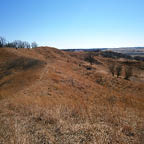 Cat Steps - Feature of the Loess Hills formed by moving soil. They are parallel, horizontal terraces that resemble steps from a distance.
Cat Steps - Feature of the Loess Hills formed by moving soil. They are parallel, horizontal terraces that resemble steps from a distance.
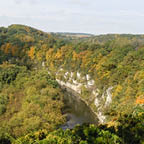 Driftless Area - The Driftless Area in northeastern Iowa is part of a larger region in the upper Midwest. When the last glaciers cut their way across the country, this region was untouched. As a result, deep river valleys and limestone bluffs were preserved along the Upper Iowa, Yellow and Mississippi rivers. A variety of opportunities exist to explore the area, most notably the Driftless Area Scenic Byway.
Driftless Area - The Driftless Area in northeastern Iowa is part of a larger region in the upper Midwest. When the last glaciers cut their way across the country, this region was untouched. As a result, deep river valleys and limestone bluffs were preserved along the Upper Iowa, Yellow and Mississippi rivers. A variety of opportunities exist to explore the area, most notably the Driftless Area Scenic Byway.
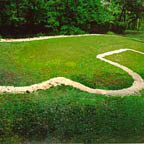 Effigy Mounds - Built by early American Indians, these raised piles of earth form the shape of birds, bears and more. Effigy Mounds National Monument in northeastern Iowa's Driftless Region is the nation's foremost educational center for interpreting the earthen mounds. The monument has received national park status.
Effigy Mounds - Built by early American Indians, these raised piles of earth form the shape of birds, bears and more. Effigy Mounds National Monument in northeastern Iowa's Driftless Region is the nation's foremost educational center for interpreting the earthen mounds. The monument has received national park status.
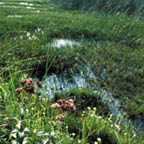 Fen - Fens are not bogs and marshes, as it's easy to assume at first glance. Instead, these natural areas are spring-fed with mineral-rich groundwater. They are always flowing, even though it can sometimes be hard to tell. Fens are typically found on terraces of streams, hillsides or rivers with mucky soil.
Fen - Fens are not bogs and marshes, as it's easy to assume at first glance. Instead, these natural areas are spring-fed with mineral-rich groundwater. They are always flowing, even though it can sometimes be hard to tell. Fens are typically found on terraces of streams, hillsides or rivers with mucky soil.
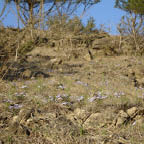 Goat Prairie - Steep, hilly prairies typically found in northeastern Iowa's Driftless Region. They are formed on south and southwest facing slopes and support dry conditions. Little bluestem, pasque flowers and purple prairie clover are commonly found on goat prairies. Unfortunately, only a few remnant spots still exist today.
Goat Prairie - Steep, hilly prairies typically found in northeastern Iowa's Driftless Region. They are formed on south and southwest facing slopes and support dry conditions. Little bluestem, pasque flowers and purple prairie clover are commonly found on goat prairies. Unfortunately, only a few remnant spots still exist today.
 Heritage - The importance of protecting, preserving and restoring Iowa's natural areas so we may leave the state as we found it for future generations to enjoy.
Heritage - The importance of protecting, preserving and restoring Iowa's natural areas so we may leave the state as we found it for future generations to enjoy.
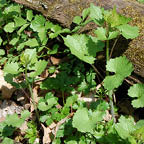 Invasive Species - Non-native plant, animal or fungus species that intrude upon a native habitat. If left unchecked, invasive species can damage natural areas, push out native species and take control of an ecosystem. Common invasive plants in Iowa include Garlic Mustard, European Buckthorn and Japanese Knotweed.
Invasive Species - Non-native plant, animal or fungus species that intrude upon a native habitat. If left unchecked, invasive species can damage natural areas, push out native species and take control of an ecosystem. Common invasive plants in Iowa include Garlic Mustard, European Buckthorn and Japanese Knotweed.
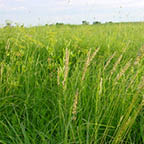 Junegrass - Native prairie grass that is commonly used in seed mixes to restore remnant prairies. It's a hearty plant able to withstand drought and helps curb erosion.
Junegrass - Native prairie grass that is commonly used in seed mixes to restore remnant prairies. It's a hearty plant able to withstand drought and helps curb erosion.
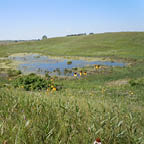 Kettlehole - These shallow depressions were formed by retreating glaciers. Chunks of ice would drop off, bury into the sediment and eventually melt. The hole left behind is called a kettle, and wetlands form within them.
Kettlehole - These shallow depressions were formed by retreating glaciers. Chunks of ice would drop off, bury into the sediment and eventually melt. The hole left behind is called a kettle, and wetlands form within them.
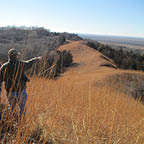 Loess Hills - The Loess Hills in western Iowa feature alternating peaks and saddles to carve out an irregular topography. They were formed during the last ice age period when wind rearranged the landscape. Iowa's Loess Hills are a rarity. In fact, only China has loess deposits that are higher. Over time, human interference with natural processes allowed trees to encroach upon the hills and overtake the grasslands. Today, many sections of the the Loess Hills are being restored to their original state.
Loess Hills - The Loess Hills in western Iowa feature alternating peaks and saddles to carve out an irregular topography. They were formed during the last ice age period when wind rearranged the landscape. Iowa's Loess Hills are a rarity. In fact, only China has loess deposits that are higher. Over time, human interference with natural processes allowed trees to encroach upon the hills and overtake the grasslands. Today, many sections of the the Loess Hills are being restored to their original state.
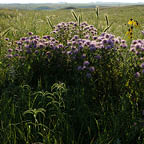 Mesic Prairie - Mesic are the Goldilocks of prairies--not too wet and not too dry. They support a diverse array of plant and animal species. At one point in time, mesic was the most common type of prairie in Iowa. But their medium-moisture quality made them ideal for agriculture and most were converted to cropland.
Mesic Prairie - Mesic are the Goldilocks of prairies--not too wet and not too dry. They support a diverse array of plant and animal species. At one point in time, mesic was the most common type of prairie in Iowa. But their medium-moisture quality made them ideal for agriculture and most were converted to cropland.
 Nitrogen - Iowa's agriculture is a key part of our state's culture. Unfortunately, nitrogen from fertilizer has infiltrated our soil and waterways, reducing water quality. Organizations like Iowa's Water and Land Legacy are trying to permanently and constitutionally protect our waterways.
Nitrogen - Iowa's agriculture is a key part of our state's culture. Unfortunately, nitrogen from fertilizer has infiltrated our soil and waterways, reducing water quality. Organizations like Iowa's Water and Land Legacy are trying to permanently and constitutionally protect our waterways.
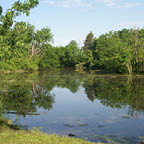 Oxbow - A bend in a stream that has been largely cut off from the main flow of the river. This creates a little lake/wetland area where species, such as the Topeka Shiner, thrive.
Oxbow - A bend in a stream that has been largely cut off from the main flow of the river. This creates a little lake/wetland area where species, such as the Topeka Shiner, thrive.
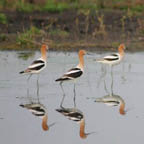 Prairie Potholes - Depressional wetlands formed by glacial movement. Some are permanent, while others are ephemeral (meaning they show up only after heavy rain or snow melt). The Prairie Pothole Region and its surrounding grasslands support an incredible diversity of birds and other wildlife. Iowa lies in the southern arm of the region, and thus serves as a gateway for migrating waterfowl.
Prairie Potholes - Depressional wetlands formed by glacial movement. Some are permanent, while others are ephemeral (meaning they show up only after heavy rain or snow melt). The Prairie Pothole Region and its surrounding grasslands support an incredible diversity of birds and other wildlife. Iowa lies in the southern arm of the region, and thus serves as a gateway for migrating waterfowl.
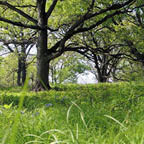 Quercus - The genus for Oak, which is Iowa's official state tree. There are 12 native species of oak, but bur oak is the only one that can be found in every region of the state.
Quercus - The genus for Oak, which is Iowa's official state tree. There are 12 native species of oak, but bur oak is the only one that can be found in every region of the state.
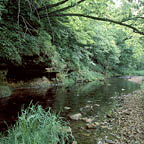 Riparian - Refers to something, such as a woodland, that lies adjacent to a river or stream.
Riparian - Refers to something, such as a woodland, that lies adjacent to a river or stream.
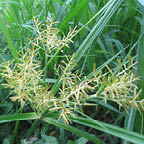 Sedge - Sedges are a diverse group of grass-like plants, typically found in wetlands or areas with poor soil. The adage "sedges have edges" speaks to the plant's triangular shape, as opposed to the flatness of grass. Many prairies are a mix of sedges, grasses and forbs (wildflowers).
Sedge - Sedges are a diverse group of grass-like plants, typically found in wetlands or areas with poor soil. The adage "sedges have edges" speaks to the plant's triangular shape, as opposed to the flatness of grass. Many prairies are a mix of sedges, grasses and forbs (wildflowers).
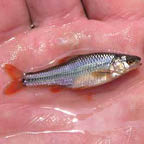 Topeka Shiner - This federally endangered little fish once swam prolifically through Iowa's streams and rivers. Habitat loss, specifically the disappearance of oxbows, has lead to its decline. Conservation groups, like the U.S. Fish and Wildlife Service, the Iowa DNR and INHF have worked to restore Topeka Shiner habitat.
Topeka Shiner - This federally endangered little fish once swam prolifically through Iowa's streams and rivers. Habitat loss, specifically the disappearance of oxbows, has lead to its decline. Conservation groups, like the U.S. Fish and Wildlife Service, the Iowa DNR and INHF have worked to restore Topeka Shiner habitat.
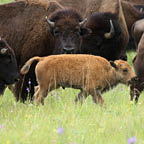 Ungulates - This term simply means "hoofed animal." Iowa used to have a diverse population of native ungulates, including bison and elk. However, over hunting and habitat loss led to their disappearance from the state. Small captive herds can be found today at places like the Neal Smith Wildlife Refuge in Jasper County.
Ungulates - This term simply means "hoofed animal." Iowa used to have a diverse population of native ungulates, including bison and elk. However, over hunting and habitat loss led to their disappearance from the state. Small captive herds can be found today at places like the Neal Smith Wildlife Refuge in Jasper County.
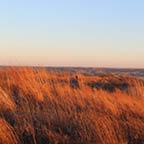 Vegetation - At one point, Iowa's landscape was mainly prairie. Today, less than 1/10 of 1 percent of our original prairies remain today. This decline has lead to the loss of unique vegetation and wildlife species. However there is hope. INHF, and our many partners, are continually working with landowners to restore remnant prairie to its original state.
Vegetation - At one point, Iowa's landscape was mainly prairie. Today, less than 1/10 of 1 percent of our original prairies remain today. This decline has lead to the loss of unique vegetation and wildlife species. However there is hope. INHF, and our many partners, are continually working with landowners to restore remnant prairie to its original state.
Wind Energy - Iowa is the nation's leader when it comes to the percentage of total energy generated from wind power. Wind energy is clean, renewable and powerful, and it helps reduce our state's carbon footprint.
Xylem - This woody tree tissue carries water and nutrients from the roots to the rest of the tree.
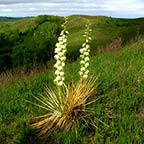 Yucca - Found in western Iowa's Loess Hills, this tall prairie plant looks as if it belongs in a desert. Numerous long, skinny leaves surround the base of the plant, while a tall flower stalk shoots up from the center. White, cup-shaped flowers bloom in June along with capsule-shaped fruits. Yucca plants have been spotted on Turin Prairie, one of the many areas in the Loess Hills INHF has helped protect.
Yucca - Found in western Iowa's Loess Hills, this tall prairie plant looks as if it belongs in a desert. Numerous long, skinny leaves surround the base of the plant, while a tall flower stalk shoots up from the center. White, cup-shaped flowers bloom in June along with capsule-shaped fruits. Yucca plants have been spotted on Turin Prairie, one of the many areas in the Loess Hills INHF has helped protect.
Zebra - Iowa used to have plentiful herds of zebra until the...just kidding. Z is always for zebra.